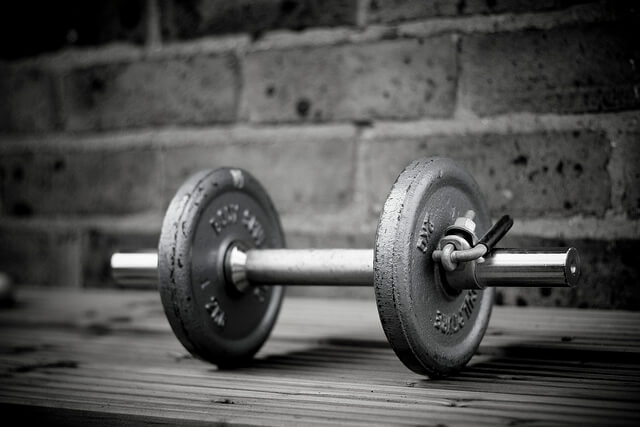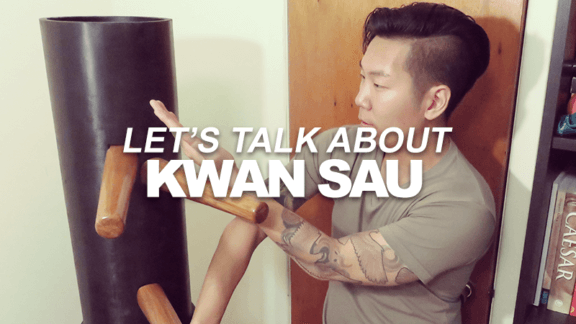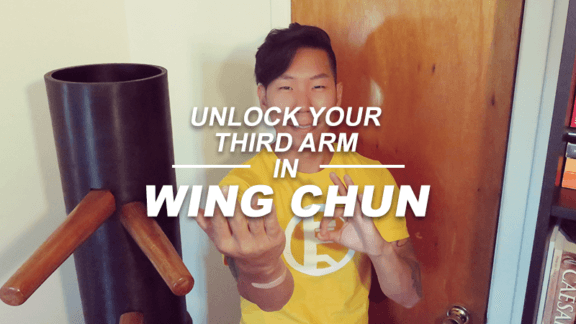Wing Chun Conditioning Exercises for Men and Women (Beginner Friendly)
Many skills that we acquire in life, we condition for it and train so that when it is time to use these skills, they come naturally. In Wing Chun, we learn the open hand forms to get our bodies conditioned to automatically respond to certain attacks. We must also train our bodies to get used to feeling the force behind an attack such as when we Tan Sau a punch or Chain Punch someone.

*Note: These are exercises that I do that I’ve learned from class as well as from personal experience. If you plan on doing these exercises and have never done them before, please consult with a fitness expert or physician to see if you should be doing them. Also, be sure to take a break in between days to give your muscles rest.
Upper Body
There are three exercises I focus on when I work out for Wing Chun that involves my upper body, they are: knuckle pushups, two-handed dumbbell curls, and neck resistance training.
1. Knuckle Pushups: These are straightforward and are done like pushups except they are done on the knuckles. Here’s a video on how to properly do a Knuckle Pushup.
Knuckle Pushup Tutorial
I start off by doing three sets of knuckle pushups of 8 repetitions each. I do them between each open hand Wing Chun form. Here’s my routine:
Sil Lim Tau -> 8x Knuckle Pushups -> Chum Kiu -> 8x Knuckle Pushups -> Biu Tze -> 8x Knuckle Pushups.
The purpose of doing pushups on the knuckles is because it strengthens the knuckles as well as the wrists and at the same time, it works on your punching power. Be sure to do each pushup correctly and with good form. Good form is when you keep your core (stomach area) tight and your body straight. Proper pushups are when you go all the way down and pushup with only the strength of your arms.
These are difficult. If you have to, you should break up the repetitions to 4x each and break for 30 seconds, then finish the 4x to total the complete 8x repetition.
If you’re already familiar with Knuckle Pushups, I suggest giving the Modified Knuckle Pushups a try. This is a great exercise to increase power in short distance punching (think one inch punch). Here’s how they’re done.
How to Do a Modified Knuckle Pushup
2. Two-Handed Dumbbell Curls: The purpose of the Two-Handed Dumbbell Curl is to imitate the six and a half point long pole training without having the long pole. Here’s a video of the training (just the first part):
Wing Chun Long Pole Training
I usually do this exercise in two sets at 10 repetitions each and I change hand position after my first set. I do these after the Knuckle Pushups and open hand forms. Actually, before I do these, I do the Wing Chun dummy form open hand (without a dummy) just so I can work on my visualization of the form and not get rusty even if I don’t practice on the dummy.
Normally this exercise is done with a long pole by using the hands to hold one end of the long pole while keeping the other end from hitting the ground. To emulate this, I use my adjustable dumbbell and leave 10lbs on one side. Here’s a quick video I made to show you how it’s done.
Wing Chun Long Pole Training w/ Dumbbell
Of course, more weight can be added but 10lbs is a good starting point. This is great training for the long pole form as it builds up the strength in the entire arm: wrists, forearms, biceps, and shoulders.
3. Neck Resistance Training: If you practice Wing Chun, you should know that we have many attacks targeting the neck and the reason is because our neck is one of the most vulnerable parts of our body. One way to strengthen our necks is through Neck Resistance Training. Here is a video detailing how you can train your neck to make it stronger.
Manual Neck Resistance Training
As you’re strengthening your neck, you have to remember that your neck is still vulnerable and you should continue to protect your neck by keeping your chin down to defend it against attacks.
The last thing I want to cover is not much a physical exercise but more of a mental drilling to remain relaxed. Staying relaxed is one of the hardest things to accomplish in Wing Chun. During intense Chi Sao sessions, my shoulders always stiffen and I become very predictable when I strike and I am always told to relax my shoulders. Usually when I do, I also start relaxing my entire body. So one thing that I recommend doing if you have trouble relaxing is to drop your shoulders. Do this everywhere, not just in Wing Chun class but when you’re walking, sitting, eating, and whenever you feel your body tensing up. By doing this, you’re training yourself to drop your shoulders whenever you tense up and once you relax your shoulders, the rest of the body follows.
Lower Body
There are three exercises I want to focus on to condition our lower bodies for Wing Chun, they are Squats, Burpees, and Kettlebell Swings. Before beginning, a quick warm up is in order to get the body warmed up. I usually do 25 Jumping Jacks to get my heart pumping and body ready.
1. Squats: This exercise is straightforward, and not fancy. Squats are basically the equivalent of pushups but for legs. Here’s a great video with clear instructions on how to do Squats.
How to Do Squats
Squats are great for working out the legs, thighs, and core, and great for increasing kick power (think front kick). If you don’t normally do squats, you should feel the burn in your legs almost instantly. I usually do 20 repetitions per set, doing three sets with a 30 second break in between. If this is too easy for you, add some weight to it by holding dumbbells as you’re squatting down. Here’s a video of how that looks like.
Squats with Dumbbells
2. Burpees: This exercise may sound funny but at the end of this workout, you won’t be laughing. Here’s a quick video showing you what burpees look like.
Burpees Demonstration
To do a Burpee, you want to start by standing with your feet shoulder distance apart. The first step is to squat down then launch into a push up position but don’t do a pushup (they’re optional). Make sure you’re in good form. Good form is when your stomach is flexed and your hips are away from the ground. Next, jump your feet back in so you’re back in a squatting position then as you’re getting up, jump and try to reach as high as you can as if you’re trying to reach for the sky. Once you land on your feet, that’s one repetition. You want to do at least 10 repetitions per set, three set total.
These are hard. You want to do these slow until you get the hang of them. And when it gets easy, start throwing in some pushups as you go down. Here’s a quick break down:
10x Burpees -> 45 Second Rest -> 10x Burpees -> 45 Second Rest -> 10x Burpees -> 45 Second Rest.
Burpees are an amazing exercise because it’s an entire body workout with emphasis on building core strength. The core is a vital part of your body because I consider it to be the foundation where the strength behind our punches and kicks come from. Not only does it strengthen the core, Burpees also works out our legs and increases our explosiveness when we step in to intercept an attack and the power of our kicks!
3. Kettlebell Swings: To do the Kettlebell Swings, you will need a kettlebell. There are alternatives; you can use a dumbbell or a book bag stuffed with textbooks or weights. I highly recommend the dumbbell if you don’t have your own kettlebell.
The weight here is up to you. I can go up to 60lbs but your limit might be different. If you’re just starting out, 10lbs is a good weight to start with and from there, slowly build your way up until you know your maximum weight.
Before I start the Kettlebell Swings, I warm up with Kettlebell Deadlifts.
3a. Kettlebell Deadlifts
How to Do Kettlebell Deadlifts
I usually do 10 repetitions a set, doing three sets with a 30 second break in between. After we’re done with the deadlifts, we start the Kettlebell Swings.
3b. Kettlebell Swings
How to Do Kettlebell Swings
I do ten repetitions per set, doing three sets and resting for 30 seconds in between sets.
Kettlebell Swings are definitely underrated and deserves more recognition for being a great full body exercise because benefits of doing this exercise is huge. Like Burpees, it works out your entire body! One thing that this exercise emphasizes on is the hips. The strength from doing each Kettlebell Swing comes from our hips with minimal focus on our arms. This exercise is great for improving your hip work which comes in very handy for Wing Chun because our hips, like our core, connects with our punching, shifting, and explosiveness when stepping in.
Once again, you don’t need kettlebells to do this exercise; you can do this workout with a dumbbell. Here’s a video of how it looks like doing a Kettlebell Swing with dumbbells.
Dumbbell Swing
Alternative Grip Dumbbell Swing
This is the end of the Wing Chun body conditioning series. I hope it has given you an idea of how a lot of exercises are synergistic to Wing Chun training.
3 Exercises That Benefit Your Wing Chun Training
Your body is your weapon so exercise to keep it focused.
If you can’t do the upper and lower body exercises already discussed, here are 3 exercises that are a must do and will greatly benefit your Wing Chun training!
*Note: I am not a personal trainer or fitness expert. If you plan on doing these exercises and have never done them before, please consult with a fitness expert or physician to see if you should be doing them. Also, be sure to take a break in between days to give your muscles rest.
1) Knuckle Push Ups – Condition your knuckles and increases your punching power.
2) Squats – Trains your legs, core (stomach area), and increases your kicking power.
3) Burpees – Combines both push ups and squats for an all body work out.
I think a good starting point if you’re just starting is 3×3 (3 sets of 3 reps). With the exception of Squats, I would recommend 3×6 (3 sets of 6 reps) instead.


